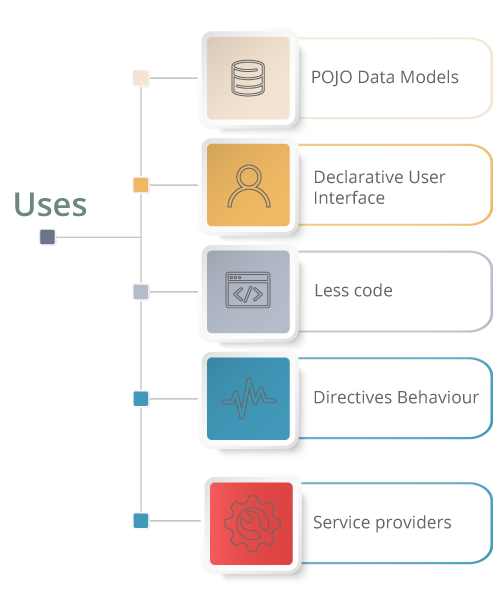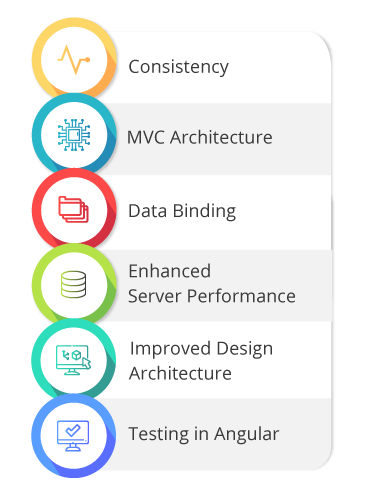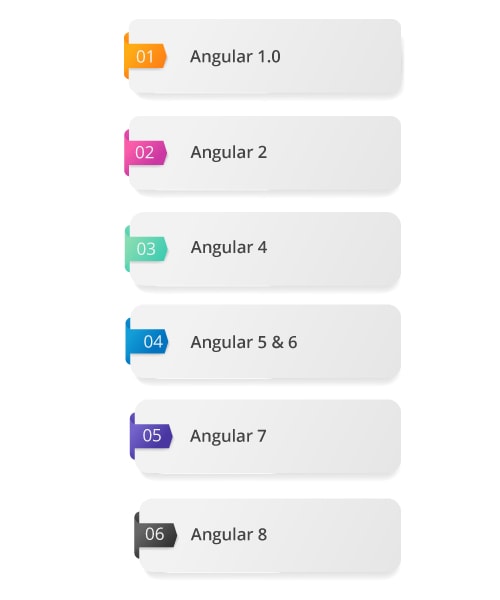
What is Angular?
What is Angular?
Angular, developed by Google, is the best open-source framework available for software engineers to build contemporary, and lively applications with the help of CSS, HTML, and TypeScript/ JavaScript. Angular got introduced in the year 2009 and this specific framework has received enormous grip for many years for eradicating redundant code. Quicker and lighter applications are ensured by Angular.
TypeScript is most often used to write Angular. For Angular application, NgModules is the fundamental building block that offers a compilation context for components. A set of modules clearly defines an Angular app. Angular is a widespread and frequently employed framework. In this blog, we will discuss on advantages & disadvantages of Angular, why to use Angular, different versions available in today’s market, future of Angular and so on. This would really help the freshers and new developers in order to provide a wonderful result in their job and career.
Why use Angular?
Angular is one of the frameworks in which we can expect the tools to work with any other tools in a consistent method. Below are the most known reasons to answer the question “Why to use Angular”? We may also mention these reasons as the features of Angular.
POJO Data Models:
Angular has the Data Models which are POJO (Plain Old JavaScript Objects) and unimportant setter and getter functions are not required. It is your wish to directly add, modify properties and loop over arrays and objects as per the need. The code gets displayed in a clearer and more spontaneous method. Outdated data models are accountable for server syncing and data persistence, hence these models act as a clever data provider.
But, when talking about Angular’s data models, they have plain objects which are behaving like a corkboard. Do you know what is a corkboard? A corkboard is simply a temporary storage sector that helps the users to place and recover data. We can see Angular’s cork boards are closely working with a view and controller. Angular calls this as ‘Scope’ in order to distinguish from traditional data models.
Declarative User Interface:
For defining the application user interface, HTML is used by Angular. HTML is the language that is much instinctive and less complicated, instead of using JavaScript to describe the interface procedurally.
Less code:
Writing an own MVC pipeline is not required in Angular. With the help of HTML, the view is defined which is further brief. Without setters/getters, Data models of Angular are easier to write. Manual placement of data into view is not expected and this is known as Data binding. Directives are written by a separate team with nominal integration problems as directives do not coincide with app code. Without modifying controllers, you can simply manipulate data on the view level using the Angular filters. Hence, writing code becomes very less, which is a major concept included with Angular.
Directives Behaviour:
The method of Angular bringing additional HTML functionalities are Directives. Can you imagine a world with lots of HTML rich elements like <grid></grid>? Then manipulating DOM to simulate them is not at all required. The only task that we need to concentrate is assigning attributes to elements just to work on All that our app needs to do is to assign attributes to elements. This concept can be achieved using Directives as it enables the creation of HTML elements on our own. On placing the entire DOM manipulations code within Directives, it is possible to separate from the MVC app. In this way, we can permit our MVC app to update the view with fresh data.
Service providers:
We have many standalone objects in Angular apart from the app which is called Services. These services allow the controller to stay slender and devoted to scope and sight to which it is assigned to.
Advantages of Angular
Before jumping into a new framework or technology, we need to know about it in order to acquire its entire benefits and create productive results. Most of the developers, managers and technical people are interested to know the advantages of Angular. The reason for getting to know the benefits are all are concerned about treating change requests, framework existence duration, maintenance of the application, productivity by developer, technology pace, and many more. Below are some of the crucial advantages of Angular.
Consistency:
To support production applications, you need to understand the consistency of the code. For any code-based applications, code consistency is a significant mission to struggle for. Angular affords a consistent framework, services, and components.
MVC Architecture:
While creating a client-side app through Angular, values are attached to the frameworks using Model View Controller (MVC) architecture. In addition, foundations are set for other vital features such as scopes and data binding. Without adding further code, MVC mechanically combines the entire application elements.
Data Binding:
We can see data flowing in two directions, one is to the controller (C) from source and another from the controller to the source. As we have this advantage, we have the probability to modify both view and model just by changing the value. Using the concept called One-way data-binding architecture in Angular, you will be able to modify data value in the model to see the alterations in the view.
Enhanced Server Performance:
At the time of app creation, you need to know the performance details like receptiveness for user’s requests, primary loading time and so on. There is an excessive impact on conversion, user maintenance and application rating in terms of Mobile app performance. You can easily reduce the server CPU workload, support caching and few more important processes using Angular.
Improved Design Architecture:
There are many numbers of components available in large web applications. Angular is offering various methods to simplify the management process when a new programmer is joining the project at the beginning of the development process. The built architecture aids the programmers to find and perform code development without any trouble.
Testing in Angular:
Generally, in development and production processes, testing is an important part. Angular framework got built with various features that support testing. Using DI features, test data can be inserted easily within the controller by testers to analyze its output and performance. In addition, the Angular framework contains an enthusiastic unit-test runner that can be helpful in verifying the performance of the application.
Must Read: Angular 2 Interview Questions and Answers
Disadvantages of Angular
Documentation:
Always, we need to have dependable documentation to help the users for app creation. Though the framework documentation got updated, many improvements are still required. It is always better to augment a few more valuable evidence to some approaches and properties, modifications and features comparison. Finely prepared documentation with step-by-step commands would save more time and also shortens the development process.
Debugging:
At the time of application building, Debugging plays a major role. Utilizing the scopes becomes very simple but debugging those become very difficult. Many times, there exists confusion among developers as they don’t have any idea of which scope is used and the value of debugging the scope.
Sharp Learning curve:
A new candidate can learn Angular easily in the initial stages. But, when moving towards the advanced stages, you may find many difficulties and the learning curve could be a steeper one.
Less protected:
In Angular, server authentication and authorization are not available. Granting approvals to access data and confirm credentials to identify a user is called Authorization. Angular will not be able to provide both features and hence we say Angular is less secure.
Unsupported Versions:
There are few browsers that do not support Angular. Hence, we need to do a prior check before implementing the application with Angular technology.
Angular Versions
The versions of the Angular framework are from 2 to 8. Whenever there is a new framework available in Angular, we call it with a new version just to evade terminology misunderstanding. The latest 8th update got released in the year 2019, May. Version 9 is expected to release in October 2019. Now we can discuss the details and improvements on Angular versions.
| S. No. | Angular Versions | Description |
| 1. | Angular 1.0 | Angular 1.0 is the initial version got released in the year 2010 and entirely based on controllers. $scope is used to view communicate. Just one crucial issue in Angular 1.0 is search engine friendliness. |
| 2. | Angular 2 | Various changes are performed in the initial framework leading to Angular 2, which was rewritten in TypeScript. Angular 2.0 is released in the year 2014 supporting mobile. Due to TypeScript, a fresh in-built compiler is available in Angular 2. $scope is removed in Angular 2 and this version is faster than Angular 1.0. |
| 3. | Angular 4 | Angular 4 introduced a concept HttpClient which is quite easy to use, small and contains an efficient library to make HTTP requests. This version got released in the year 2017. Resolvers and Guards received fresh life cycle events from Angular 4. The core element called Angular CLI 1.0.0 was introduced in this release. |
| 4. | Angular 5 & 6 | Few improvements on web apps, the material design ended in Angular 5 release. This version got released in the year 2017, November. The main concentration of Angular 5 & 6 is on optimizing compiler work and Angular CLI. Web worker’s function and the entire CLI enhancements are also introduced in Angular 5 and 6. Google’s Material Design SDK is introduced by Angular 6.0. |
| 5. | Angular 7 | Angular 7 is enhanced with various prompts and got released in the year 2018. To explain the usage of each element and functions, tips are provided in CLI with the help of prompts. We can see numerous improvements in application performance and codebase size. Virtual scrolling, CDK and Angular material are the advanced features available in Angular 7. |
| 6. | Angular 8 | Angular 8 is the latest version and we have two elements introduced which are Bazel and Ivy renderer. Differential Loading is another enhancement to support uploading content faster and legacy browser. |
Angular Tools
| S. No | Angular Tool | Description |
| 1. | Angular CLI | For a fine scaffolding and encapsulated build, you can use the number on Angular tool called Angular CLI. Users are allowed to rapidly enhance projects by mechanically affording the testing and build configuration. Angular CLI provides a smooth combination with various other projects like Angular Mobile Toolkit, Angular Material, Angular Mobile Toolkit, and Angular Core. |
| 2. | Codelyzer | Codelyzer utilizes CSS parsers and an Angular template to afford more cultured examination of the application. You can also use Codelyzer to spot misspelled variables existing in the templates, routinely migrate a project across various Angular versions. |
| 3. | Snippets | A package of snippets is created by John Papa to improve productivity by lessening the boilerplate tasks while declaring directives, a new component, route, service, guards, etc. Install the VSCode extension to acquire the entire advantages of snippets. |
Angular Certifications
| S. No | Certification Name | Description |
|
1. |
Angular 8 – The Complete Guide | People with zero knowledge of Angular can opt for this Angular 8 course and certification. It’s a perfect start from scratch enabling the learners to develop complicated, approachable and scalable web applications. You can get more knowledge on Directives, Authentication, Components, and Http Access. The total duration of this course would be 37 hours. |
| 2. | Angular JS | To know the basic concepts of JavaScripts which empower AngularJS, join this course. Single Page Application, building a weather forecast, transclusion, and dependency injection are some effective learning from this course. The total duration of this course would be 7 hours. |
| 3. | Angular Crash Course | To have quick learning, you need to opt for the Angular Crash course. To take up this course, it is better to know the fundamentals of CSS, HTML, and JavaScript. Displaying Data, Typescript basics and Handling events are the learnings from the Angular Crash course. Approximately 11 hours are expected to complete this course. |
| 4. | Complete Angular Course – Beginner to Advanced | The complete Angular course is for the candidates who are looking for the whole understanding of Angular from the beginning to the core concepts. You can become a full-stack developer or a front end developer on completing this course. The total duration would be 29.5 hours. |
| 5. | Angular 2+ and NodeJS | To get knowledge on how to connect Angular Frontend with NodeJS Backend, you need to join this Angular 2+ and NodeJS certification course. You can easily create high-speed web applications using Angular 2 or NodeJS. Fundamentals on MongoDB and NodeJS, application optimization and deployment, how to create custom seed assignments are some of the highlights of this certification course. You can complete this course in 12.5 hours. |
| 6. | Front-End Angular Certification | Front-end Angular Certification is to make you an expert in various features and concepts of Angular like services, directives, and components. Candidates are expected to have the practical knowledge of developing SPA (Single Page Application), Data Binding, and design reactive forms or template-driven forms. You will be taught how to use Angular Material and Flex layout to design approachable applications. The duration to complete this course would be approximately 8 hours a week and in a total of 4 weeks. |
| 7. | Single Page Web Application – Angular Certification | On completing this Single Page Web Application certification course, you will be able to build applications with the well-known frameworks, learn components and code arrangement methods, how to improve web app functionalities and so on. You can easily work on various hands-on projects. The duration of this course would be 38 hours in total. |
Now let us discuss the differenced between Angular, Angular JS and React JS.
Angular Vs Angular JS
| Parameters | Angular | Angular JS |
| Architecture | The major building blocks of Angular are directives and components | Angular JS architecture is based on Model View Controller (MVC) |
| Language | Microsoft’s TypeScript languages are used to write Angular | JavaScript is used to write Angular |
| Syntax | For property binding, Angular is focussing on ‘[ ]’ and for event binding, Angular is focussing on ‘( )’ | In Angular JS, the correct ng directive is used to bind a property/image or an event. |
| Routing | To configure routing, Angular is using @RouteConfig{(…)} | To configure routing, Angular JS is using $routeprovider.when() |
| Mobile Support | Mobile Support feature is available in Angular | Mobile Support feature is not available in Angular JS |
| DI (Dependency Injection) | A hierarchical Dependency Injection is implemented in Angular with the help of providers, declarations, and constructor functions. | DI is placed into numerous controller functions, link functions, and directive definitions in Angular JS. |
Angular Vs React JS
| Parameters | Angular | React JS |
| Release Date | Angular released in the year 2016 | React JS released in the year 2013 |
| Languages | Angular written with TypeScript | React JS written with JavaScript |
| Data Binding | Data Binding of Angular is two way (bidirectional) | |
| DOM | Real DOM is used in Angular | Virtual DOM is used in React JS |
| Testing Framework | The testing framework used in Angular is Jasmine | The testing framework used in react JS is Jest |
| Companies | The companies using Angular are Upwork, Sony, Forbes, Google, HBO, and Nike. | The companies using React JS are Uber, WhatsApp, Facebook, Instagram, Netflix, and Dropbox. |
| Availability | Angular is available as a full framework | React JS is available as a small view library |
Angular in 2020
Angular 9 is expected to get released in the year 2020. The fact is the release was planned for October or November of 2019, but due to various reasons, the release date is pushed to 2020. The exact date is not yet published. Angular is one of the top projecting JavaScript frameworks to develop numerous web applications suitable for both desktop and mobile. So, the popularity of Angular is of no doubt and it has various new features helping all the developers. Below are some of the predictions and trends of Angular expected in the year 2020.
- Web Components: Web components in Angular is expected to work in unconvinced method. With or without a framework, web components can work. To define custom behaviors and elements, a set of JavaScript APIs are provided along with templates like HTML and Shadow DOM.
- Active Imports: When concentrating on the performance of the application, this particular feature would help to reduce the cost and other painful factors too. You can simply load modules manually.
- Extension of Microservices: Extending the microservices is one of the new ideas seen in the front end. Front end architecture is continuing to grow high to solve various complicated big issues and result in modern applications.
- Unstoppable JavaScript: For sure JavaScript continues its supremacy in 2020. Functional programming, composing software, optional chaining for JavaScript are some of the superlative features going to trend in 2020.
Must Read: Angular 4 Interview Questions and Answers
Angular Job Roles and Responsibilities
| S. No | Job Role | Description |
| 1. | Angular Developer | An Angular Developer should have knowledge of designing, developing user interfaces with the help of AngularJS. Writing experience on HTML, JavaScript and CSS are expected. They should be able to conduct performance testing, consult with the design team, develop product analysis tasks, and ensure high performance on applications. Entry-level Angular Developer would draw approximately $65,000 per year and advanced level employees would get $185,000 per year. |
| 2. | Full Stack Front-end Developer | A Full stack developer is responsible to develop front end website architecture, back end applications, design APIs, create databases and servers for functionalities, ensure cross-platform optimization and meet both customers and technical requirements. Proficiency in Angular JS, Ember, and React is a must. The salary range would be $105,000 to $150,000 per annum. |
Some of the other Angular job roles are Web App Developer, JavaScript Developer, and UI Developer. The pay scale for each job role varies depending on the experience too.
Conclusion
Demand for Angular Developer is really high and hence you can find various job opportunities from popular job portals like Naukri.com, Indeed.co.in, Monster.com, LinkedIn, Glassdoor, etc. There are a number of JavaScript Frameworks available in the market and the developers can choose as per the need. The companies looking out for Angular Developers are Tech Mahindra, Capgemini, IBM, Elance, Wipro, iGate and many more.





 +1 201-949-7520
+1 201-949-7520 +91-9707 240 250
+91-9707 240 250